 December 2, 2008
December 2, 2008
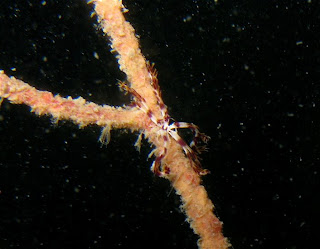
Picture courtesy: Chay Hoon
The Hantu Bloggers made its monthly trip out to Singapore waters today and had some fascinating encounters with the reefs macrofauna. From the reefs very large crinoids to very tiny ones like the one above. With a week full of spattering rainfall, the divers managed to dive in clear weather though the sky remained overcast, bringing the visibility down to 2-3 meters.
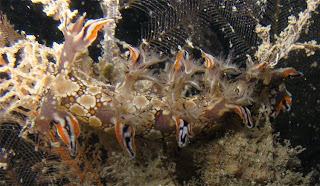
Picture coustesy: Chay Hoon
Keen-eyed nudibranch spotter and regular Hantu Blog diver Chay Hoon also managed to spot the Bornella anguilla nudibranch above which she observed devouring a mouthful of hydroid corals. And the much sought after Tritonia nudibranch below.
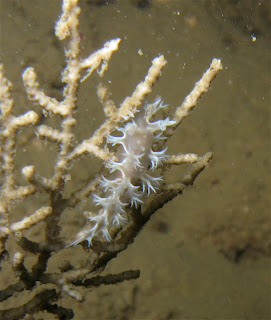
Photo courtesy: Chay Hoon
But her most exciting finds for the day (at least for the both of us!) must be the juvenile sawtooth shrimp [below]. Growing up to 3 inches, this tiny individual is exceptional with its giant, adult-sized eyes on it’s tiny and growing body!
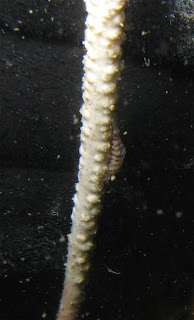
Photo courtesy: Chay Hoon
But the most outstanding find for the day for me, must be the juvenile winged pipefish [below] that is so tiny and invisible to the untrained eye that only someone like Chay Hoon can spot! Looking more like a worm when it’s young, these pipefish grow up into magnificant-looking adults with tiny appendages sticking out along the length of its sides, giving it its name. These “wings” mimick a kid of corralline algae that can also be found on the reef. When they rest amongst this algae, they blend in superbly.
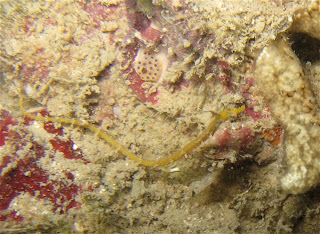
Photo Courtesy: Chay Hoon
To view more images from this dive, visit the Colourful Clouds Blog.
 Posted in Blog Log
Posted in Blog Log  No Comments »
No Comments »
 November 30, 2008
November 30, 2008

Courtesy: wildshores.blogspot.com
At today’s launch of the new edition of the Singapore Red Data Book at the Singapore Botanical Gardens, Ria Tan blogs on her WildShores Blog that Pulau Hantu is amongst other offshore marine habitats that have been recognised as critical habitats for the preservation of local biodiversity.

Courtesy: wildshores.blogspot.com
The Red Data Book has been invaluable to the work of those seeking to protect our biodiversity, and this second edition will continue to play this role.
More information about Singapore Red Data Book
 Posted in Announcements, News
Posted in Announcements, News  No Comments »
No Comments »
 November 30, 2008
November 30, 2008

- Lisa Paggeot gives and introduction

On Tuesday, The Hantu Blog had the pleasure of being invited by Singapore American School (SAS) teacher and PADI Instructor, Jim Diebley, to give a talk about marine conservation and the biodiversity of local waters.
Diebley learnt about our talk “Southern Haunt” (developed to commemorate the IYOR) when his student and Hantu Blog diver Lisa Paggeot, who joined the Blog for 2 of our dives this year, recommended we share some local knowledge of our reef with the staff and students of SAS.
I had the priviledge of being introduced before my talk by the precocious and enthusiastic 14 year-old Lisa, who has logged over 100 dives across 4 countries! Lisa, who’s contributed images of nudibranchs to Neville Coleman’s book 1001 Nudibranchs, has ambitions of becoming a nudibranch taxonomist when she grows up – a very specific career choice for most students her age! With her energy, experience, and enthusiasim, Lisa and her father Bruce have been working on the possibility of developing a tv series for the young diver to document her advantures and communicate her love for the ocean.
Members of the audience commented that despite being in Singapore for over a decade, they’d never heard talks about diving at Pulau Hantu and the diversity of Singapore’s marine life. We also discussed briefly about the future of Singapore’s reef – if it’s future is secured by existing policies or if more effort is needed by both grassroots and government organisations to safeguard it’s future. Diebley, who’s been working in Singapore for several decades indicated that is it important Sinagpore finds a means to preserve its historical and natural heritage by heightening the access and recognition of people and places of value to Singaporeans and its expat community.
More about Lisa Paggeot
Email us at hantublog @ gmail.com if you’d like us to give a talk to your school, office or club.
 Posted in Events, Seminars
Posted in Events, Seminars  3 Comments »
3 Comments »
 October 28, 2008
October 28, 2008
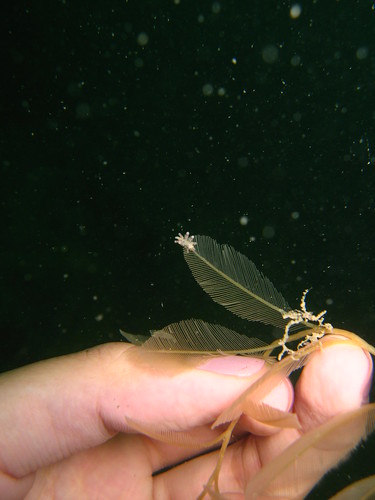
It rained this weekend on our way to Palau Hantu. Dark, grey clouds over the water create a dull landscape, not to mention a cold exit after soaking in the sea diving for about an hour! [above & below: Doto bella nudibranch on frond of Giant Hydroid]
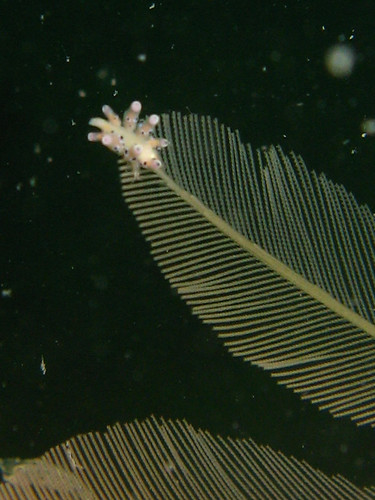
The visibility depite the overcast sky, was about 3-4 meters. In some areas, the deeper we descended, the clearer the waters were. This was to be one of the best dives I’ve had in a long time! Perhaps it’s because I descended expecting to find the usual critters but was blown away to see them and some really rare and new finds!
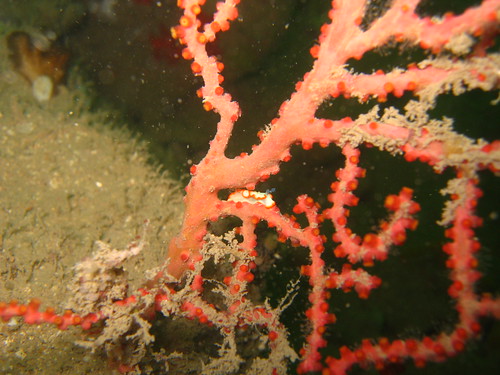
I was particularly thrilled to encounter this tiny nudibranch crawling up a sea fan. I’ve never seen it before and neither have any of the guides that were out with us on Sunday. So we’re going to try to get it identified. It’s got very interesting rhinophores and orange-tipped knobs along the length of it’s back. It’s always spactacular to find something new in Hantu! [above & below: Unidentified nudibranch]
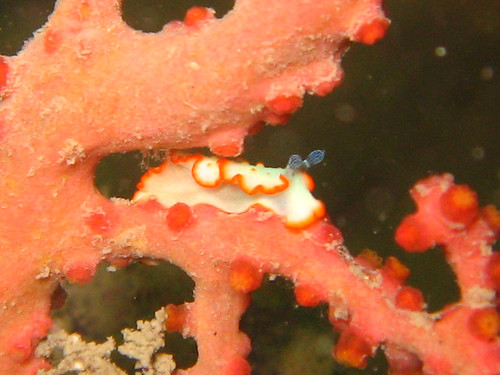
While I was on the hunt for seahorses as the usual places, I found a very unusual occupant in what could otherwise have been a seahorses’ hiding place! Can you tell what it is? It’s got a false eye-spot on it’s dorsal fin, close to its tail. This is meant to confuse would-be predators that it’s got it’s head facing them, while the REAL head makes an exit! This fish is from the family is Dottybacks and is called a Comet. They are not common to the reef and are only occasionally spotted. [below: Comet]
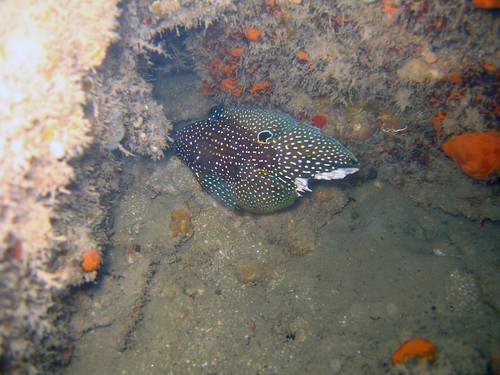
The discoveries continued to be exciting when on the way up from the 1st dive, I noticed a bright blue spot darting about a coral head. This Juvenile Emperor Angelfish looks nothing like it’s adult counterpart. Adult Emperor Angelfish look vastly different with distinct yellow lines across it’s blueish body instead of white rings. We hope this little guy manages to survive the trials of the reef and live to grow into its regal adult form! [below: Juvenile Emperor Angelfish]
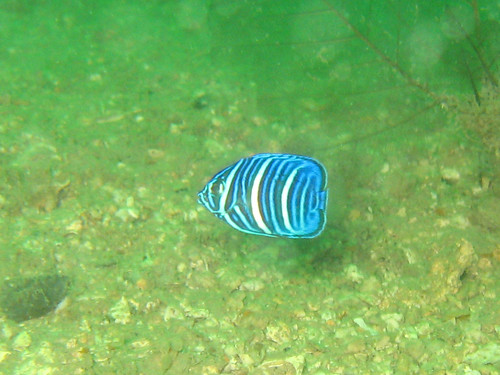
And then, something bizarre on our second dive… something we’ve not seen on the reef before. Something that’s definitely new! A foldaway, canvas, deck chair! You’re probably wondering how it got there, and how it came to rest in such a proper upright manner. Well, we’re wondering exactly the same! What a curious feature to encounter underwater!
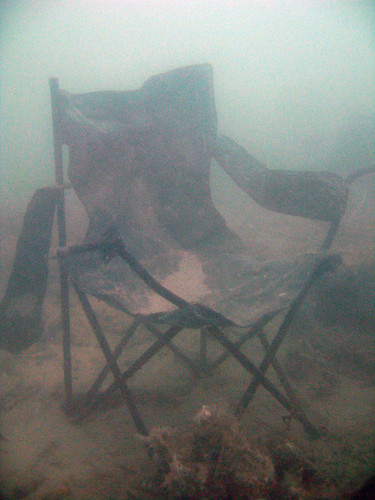
To view more exciting critters from our monthly dive at Hantu last weekend, swing by our gallery to meet the gorgeous butterflyfish, curious lizardfish, quirky crinoids and nonchalant gobies that share Singapore waters with us! Thanks to all the volunteers and members of the public for making this dive and every dive possible! Your support gives us the opportunity to discover these amazing species and if you’re reading this blog, your visitorship is what gets us these pictures! We hope you learn heaps from our blog and that perhaps a little something of what you learn will translate into pro-activity towards protecting our reefs, coasts and all the environments that nourish it. [below: A pair of Copperbanded Butterflyfish dive beautifully, nose-first into the depths of Hantu.
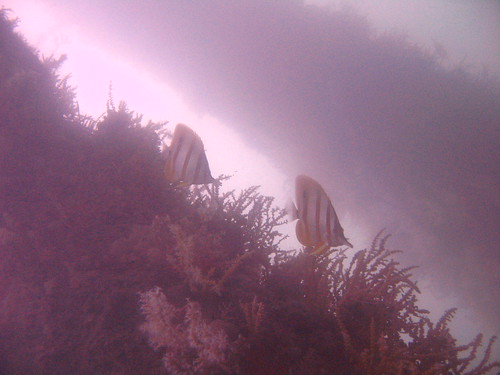
 Posted in Blog Log
Posted in Blog Log  5 Comments »
5 Comments »
 October 3, 2008
October 3, 2008

When the whole world and pretty much all of Singapore was training their eyes onto machines that were running past 300km/h, the divers with the Hantu Blog seemed content to employ a slow and easy pace with the little sea slugs and fishes that probably didn’t have a clue of what was going on above the waters surface. They probably also enjoyed a quieter weekend than the rest of us. Swing by Gerald Toh’s webpage to see his pix from our dive on Sunday.
 Posted in Blog Log
Posted in Blog Log  1 Comment »
1 Comment »
 October 2, 2008
October 2, 2008

Dr. James A. Murray, Assistant Professor at the Department of Biological Sciences at California State University, commented on the above photograph of Tritonia in Hantu waters:
Very nice, thank you for showing me your Tritonia. The Tritonia up here can get to as long as 30 cm and weight nearly 2 kg!
Dr. Murray studies the neuroethology of orientation and navigation. His work focuses on the neuroethology of orientation to tidal flow in the nudbranch sea slug Tritonia diomedea. He is also developing techniques to control behavior in animals with implanted brain electrodes.
More information of Tritonia is available here.
 Posted in Biology
Posted in Biology  No Comments »
No Comments »
 September 30, 2008
September 30, 2008

I didn’t even realise that this gorgeous little winged pipefish was spotted at Hantu this weekend till I saw the pictures on Chay Hoon’s Blog. The winged pipefish is by far my favourite pipefish. I first encountered one in the water’s off North Sulawesi and was thrilled when I had my first encounter with this critter on a night dive in local waters in March 2005! Since then, it’s been spotted by our volunteer divers and the likes of Chay Hoon on a few other occasions.


Chay Hoon has a real keen eye for spotting little tiny things on the reef. So much so that she sometimes misses the BIG STUFF since her keen are are calibrated for critters below an inch in size! The Chromodoris fidelis (top) is a nudibranch that can be found throughout the Tropical Indo-West Pacific, and can grow up to 25mm in length. At the bottom is Cadlinella ornatissima. Chay Hoon spotted 2 this weekend! I spotted this critter for the first time 2 months ago. This creature can grow up to 34mm and has a characteristic pattern of single-celled, flask-shaped and compound mantle glands.


A larger nudibranch is Hypselodoris emma (left) with its gills and rhinophores a brilliant reddish orange. And on the right is Bornella anguilla, a large nudibranch (up to 86mm) with a characteristic mosaic-like colour pattern. Its name (anguilla = eel) refers to its method of swimming. while most species of Bornella can swim by a lateral flexion of their body, in B. anguilla a muscular wave travels down the body to produce an eel-like motion. I first spotted this nudi in 2004.
Pictures: Colourful Clouds Source: Sea Slug Forum
 Posted in Blog Log
Posted in Blog Log  No Comments »
No Comments »
 September 30, 2008
September 30, 2008

The above photograph of acoel flatworms on porites coral was shot in January 2008. Acoel flatworms reproduce primarily asexually, by fission, and can quickly attain high densities with sufficient light (they have symbiotic algae) and abundant copepod prey. They are not parasitic, but can reportedly damage corals by shading. Though no easily available predator of these worms is known, aquarists have found that certain nudibranchs of the genus Chelidonura feed exclusively on acoel flatworms. These attractive nudibranchs measure 5 cm in length and are interestingly shaped similar to their flatworm prey, and possess two streamer-like appendages and a hammer-shaped head. Aquarists have described their feeding actions as best compared to a vacuum cleaner. As they come upon a flatworm, they fold part of their body and form a straw-like proboscis that they use to “suck” up the worms.
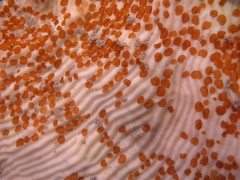

These flatworms were first noticed on Hantu Islands corals in August 2007. They were repeatedly observed on corals that shows signs of bleaching in Nov 2007, then later in April and May this year. It is not apparent what caused them to multiply this visibly in Hantu waters and since there have been no previous observations, it is difficult to pin point when exactly they began their significant presence and what caused it.
Sources: Sea Slug Forum, Advanced Aquarists Online
 Posted in Biology
Posted in Biology  1 Comment »
1 Comment »
 September 29, 2008
September 29, 2008

Divers had a sunshine-filled weekend at Hantu Island this Saturday. Visibility was about 3m, regardless, our experienced and enthusiastic guides sifted through the silt to spot some iconic critters for the divers that joined us.

The Hantu Blog guides commented that it’s been awhile since we’ve spotted allied cowries on the sea whips at Hantu, as well as the Gorgonian or Sawtooth shrimps that we were thrilled to spot in local waters. A critter we have managed to spot on our sea whips last month and just yesterday though, are these Tritionia nudibranches below. Can you spot the little one on the left?

Another critter from last month was the long-nosed pipefish or stick pipefish below.

Because of a long and tiring week, I took a hiatus from diving this weekend and relied gravely on the many shutter bugs that were present at yesterday’s dive! All the picturse in this post are courtesy of Hantu Blog guide Hui Bing. More pictures can be viewed on her Blog. Watch this blog over the next few days to see what else we saw!
 Posted in Blog Log
Posted in Blog Log  No Comments »
No Comments »
 September 9, 2008
September 9, 2008

Blog volunteer Hui Bing was out on our Blog dive on August 31st and managed to spot and photograph some rare and exciting nudibranches! She’s got a real keen eye and can make out the tiniest of critters amidst the silt, sand, and mucky waters of Hantu! We’re so privilaged to have her on our team, and you’d be lucky too if you had her for a guide!

Swing by her blog to view her nudi pictures along with some other critters in the muck!
 Posted in Biology
Posted in Biology  4 Comments »
4 Comments »
 December 2, 2008
December 2, 2008 




 Posted in
Posted in 






























 content rss
content rss
COMMENTS